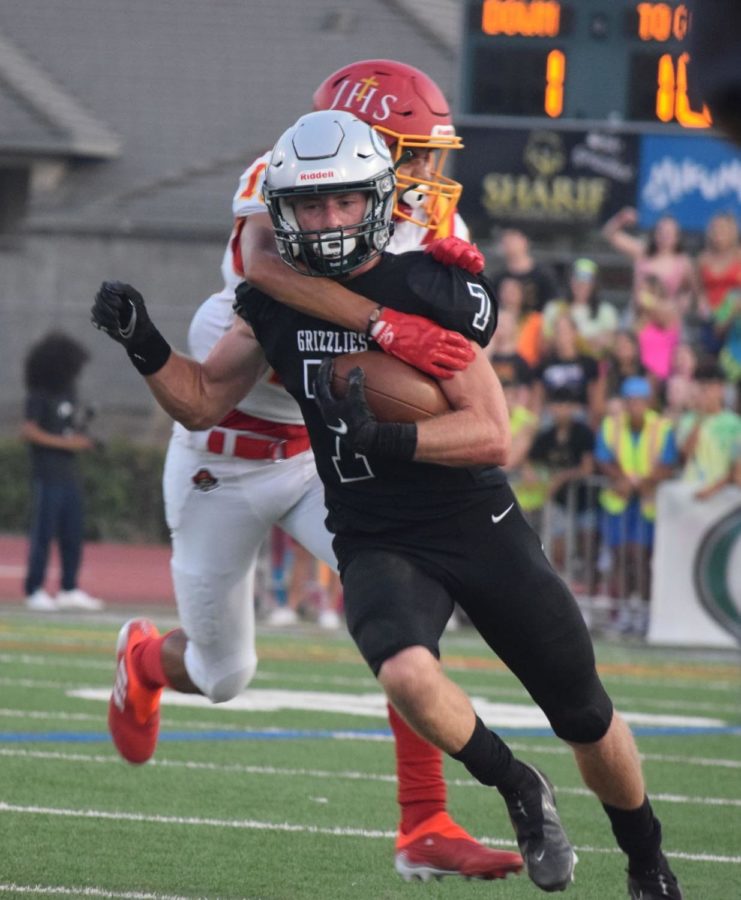Granite Bay High School senior Rosie Murphy slouched on the couch in her sport culture class wearing a UCLA sweatshirt. Although she verbally committed to UCLA for swim in 2020, coming to that decision was difficult due to limitations created by COVID-19.
The pandemic has complicated college recruitment, affecting not only how high school student-athletes have navigated the recruitment process, but how many are likely to be recruited.
“I wasn’t able to go on any official visits because of (the pandemic),” Murphy said. “Official visits are… what a lot of people use to… make a decision. It was a lot of Zoom calls with teams.”
Official campus visits occur when colleges fund any aspect of a recruit’s visit to their school. Such visits were on hold because the NCAA adopted a dead period for recruiting on March 13, 2020. A dead period is a time during which college coaches cannot talk at all to potential recruits in person.
The dead period’s waiver expired on May 31, 2021, so this recruitment restriction is currently lifted.
Coaches contacted Murphy through text or email, which is similar to what GBHS senior Grace McGuckin, who runs cross-country and distance track, has experienced.
“(College coaches and I communicate) usually through email and then we’ll talk on the phone afterwards,” McGuckin said.
Research claims that from March to July 2019 compared to March to July 2020, there was a “26% increase in email opens sent from recruits to college coaches.”
McGuckin said that another recruitment challenge brought by COVID was the limited opportunities to compete and improve her event times.
Trevor Paine, head baseball coach at William Jessup University, noted a shift towards evaluating athletes virtually to accommodate for the pandemic.
“A lot of recruiting was getting done by watching film (and) doing virtual stuff,” Paine said.
Per the NCAA, in May 2020, even college athletes found that the pandemic interfered with their opportunities. 83 percent of the college athletes surveyed agreed or strongly agreed that “local regulations regarding travel, facility closure and public travel” was a “barrier to (their) training.”
To make up for limited sports seasons, the NCAA is offering an extra year of eligibility for current college athletes. But because college seniors can return to their team to play an extra season, there are fewer roster spots.
“What’s happened with football is, because they gave all the college players extra eligibility… there just aren’t as many spots,” GBHS head football coach Joe Cattolico said.
Still a survey revealed that “43 percent of coaches in applicable spring sports expect seniors to return for an extra year of eligibility.”
At William Jessup University, Paine says, “the roster, in two years, has gone from… somewhere around 35 to close to 50, (which) is where we’re at now.”
Paine explained that William Jessup’s larger roster “meant there wasn’t as much scholarship money to go around,” but he encouraged prospective recruits to explore their options.
“There’s always an opportunity to play so just you have to… be willing to put yourself out there,” Paine said.
This story was originally published on GraniteBayToday.org on October 22, 2021.
































![IN THE SPOTLIGHT: Junior Zalie Mann performs “I Love to Cry at Weddings,” an ensemble piece from the fall musical Sweet Charity, to prospective students during the Fine Arts Showcase on Wednesday, Nov. 8. The showcase is a compilation of performances and demonstrations from each fine arts strand offered at McCallum. This show is put on so that prospective students can see if they are interested in joining an academy or major.
Sweet Charity originally ran the weekends of Sept. 28 and Oct. 8, but made a comeback for the Fine Arts Showcase.
“[Being at the front in the spotlight] is my favorite part of the whole dance, so I was super happy to be on stage performing and smiling at the audience,” Mann said.
Mann performed in both the musical theatre performance and dance excerpt “Ethereal,” a contemporary piece choreographed by the new dance director Terrance Carson, in the showcase. With also being a dance ambassador, Mann got to talk about what MAC dance is, her experience and answer any questions the aspiring arts majors and their parents may have.
Caption by Maya Tackett.](https://bestofsno.com/wp-content/uploads/2024/02/53321803427_47cd17fe70_o-1-1200x800.jpg)
![SPREADING THE JOY: Sophomore Chim Becker poses with sophomores Cozbi Sims and Lou Davidson while manning a table at the Hispanic Heritage treat day during lunch of Sept 28. Becker is a part of the students of color alliance, who put together the activity to raise money for their club.
“It [the stand] was really fun because McCallum has a lot of latino kids,” Becker said. “And I think it was nice that I could share the stuff that I usually just have at home with people who have never tried it before.”
Becker recognizes the importance of celebrating Hispanic heritage at Mac.
“I think its important to celebrate,” Becker said. “Because our culture is awesome and super cool, and everybody should be able to learn about other cultures of the world.”
Caption by JoJo Barnard.](https://bestofsno.com/wp-content/uploads/2024/01/53221601352_4127a81c41_o-1200x675.jpg)






